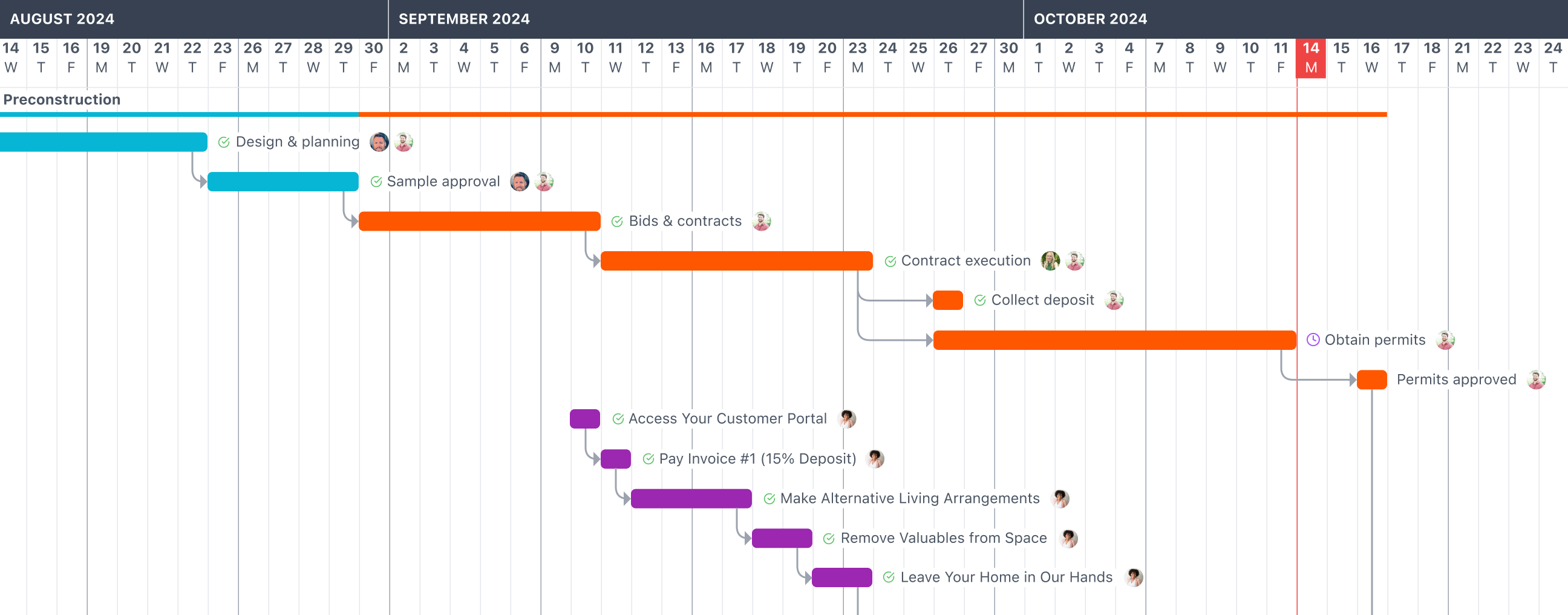The Contractor’s Guide to Gantt Charts in Construction Scheduling

Staying organized and on schedule can be a significant challenge. With multiple tasks, dependencies, and stakeholders, it’s easy for project timelines to slip and chaos to take over. That’s where Gantt charts come into play. As a crucial tool within construction scheduling software, Gantt charts allow contractors to visualize project timelines, allocate resources efficiently, and keep everyone—clients and teams—on the same page. In this blog, we explore the key benefits of Gantt charts for construction, covering how they help with organization, tracking progress, resource allocation, and communication.
What is a Gantt Chart?
A Gantt chart is a visual representation of a project schedule that uses a horizontal bar chart to display tasks over time. Each bar represents a task, showing its start and end dates. For construction projects, Gantt charts illustrate each phase from pre-construction to finishing touches, helping contractors visualize timelines, dependencies, and milestones in a clear and accessible format.
Whether you're using a construction Gantt chart on your computer or a Gantt chart MacBook app, this tool helps turn complex project details into an easy-to-follow timeline. By breaking down a construction project into smaller, manageable pieces, Gantt charts make it simpler to grasp the entire scope and flow of work at a glance.
 Construction Gantt Chart Example from JobTread Software
Construction Gantt Chart Example from JobTread SoftwareBenefits of Gantt Charts in Construction
Gantt charts are especially beneficial for contractors because of their unique ability to translate complex schedules into a visual timeline that is easy to understand. Here’s how Gantt charts help construction projects run more smoothly:
- Enhanced Organization: Gantt charts turn a potentially overwhelming project into a series of visual bars that show each task, its timeline, and its dependencies. This breakdown helps contractors identify which activities need attention, which can be delayed, and which require immediate action.
- Staying On Track with Alerts: With the ability to visualize each task in relation to others, contractors can quickly assess the impact of delays. If one part of the project slips, the Gantt chart highlights which subsequent tasks are affected, making adjustments simpler and more strategic. Many construction scheduling programs now offer Gantt chart alerts for missing hours, which ensures that any gaps or missed tasks are quickly flagged.
- Effective Communication: Gantt charts are an invaluable communication tool. Contractors can share them with clients to provide a detailed overview of project progress, while also using them with subcontractors to ensure everyone knows their timelines and responsibilities.
Are you ready to take control of your construction project's schedule?
Watch NowHow to Develop a Gantt Chart for Construction
Creating an effective construction project Gantt chart starts with breaking down your entire project into phases and assigning tasks to each phase. If you’re wondering how to develop a Gantt chart, here are some helpful steps:
- List All Tasks: Identify each activity required for the project, from site preparation to final inspections.
- Assign Durations: Determine how long each task will take.
- Establish Dependencies: Determine which tasks depend on others to be completed before they can start.
- Input Tasks into Construction Scheduling Software: Use a Gantt chart MacBook app or another preferred tool to input all these details, and visualize the construction workflow.
By inputting all of this data into construction scheduling programs, contractors can keep track of their timelines, monitor dependencies, and make necessary adjustments to stay on schedule.
Grouping Tasks or Phases Effectively
In construction, projects are typically composed of different phases: pre-construction, site work, framing, finishing, and more. Gantt charts allow contractors to group related tasks into phases, making it easier to keep track of the workflow for each segment. For instance, grouping all framing tasks together under a "Framing" header ensures you understand all the dependencies within that phase before moving to the next, reducing the chance of missing critical tasks.
 Construction Gantt Chart Example from JobTread Software
Construction Gantt Chart Example from JobTread SoftwareFor larger projects, these groupings help contractors and clients quickly grasp where the project stands without getting lost in the details. It also helps highlight where potential bottlenecks might occur, ensuring that each phase can be properly planned and executed.
Can Gantt Charts Help Allocate Resources?
Yes, Gantt charts can be a valuable resource allocation tool. In construction, the efficient use of labor, materials, and equipment is vital for keeping a project on time and within budget. Gantt charts allow contractors to:
- Enhanced Organization: By linking resources—like subcontractors, teams, or equipment—to specific tasks, contractors can prevent overlapping assignments and make sure that every team has the right support for their work.
- Identify Resource Gaps: If a Gantt chart shows that several crucial tasks overlap, it becomes clear that more resources might be needed, allowing contractors to adjust accordingly before these issues lead to delays.
This clear representation of resource allocation ensures that labor and materials are used efficiently, avoiding costly downtime or overuse.
What Are Milestones and How Do I Use Them?
In Gantt charts, milestones are key events or goals that indicate significant progress in a project. For construction, milestones can be set at crucial points such as "Foundation Completed," "Framing Done," or "Roof Installed."
Milestones help to:- Keep Teams Motivated: By breaking down a long project into smaller goals, milestones provide motivation and a sense of accomplishment as the team achieves each goal.
- Track Progress: Milestones also offer a high-level view that shows whether the project is on track overall, making it easier to communicate this to stakeholders.
Tracking Progress with Gantt Charts
Gantt charts are an ideal tool for tracking progress throughout a construction project. Contractors can mark tasks as completed or partially completed directly within the chart, allowing for a real-time assessment of the project’s health. Using construction scheduling software that offers Gantt chart examples can further streamline this process.
This kind of visual progress tracking is invaluable for:- Identifying Delays Early: A delay in one task may affect multiple dependent tasks, and a Gantt chart quickly makes this apparent.
- Comparing Planned vs. Actual Progress: Contractors can set a baseline schedule and compare it against the current state of the project, making adjustments as needed to bring the project back on course.
Using Gantt Charts for Client Communication
One of the best features of Gantt charts is their ability to improveclient communication. Many clients appreciate transparency, and Gantt charts can provide that by clearly laying out the project’s timeline and showing what has been accomplished and what remains.
By using Gantt charts:- Clients Stay Informed: Clients can easily see where the project is, what’s coming up, and any reasons for delays. This clarity reduces uncertainty and increases client satisfaction.
- Visual Updates: Instead of simply explaining that a project is behind schedule, showing clients visually how delays affect the timeline makes it easier for them to understand the challenges and have realistic expectations.
Learn How JobTread's Scheduling Helped Iconic Custom Home Builders Win a $300,000 Job
Read MoreConclusion
Managing construction projects can feel overwhelming, especially when juggling multiple teams, tasks, and deadlines. But tools like Gantt charts and construction scheduling software can help make everything feel a lot more manageable.
Whether you're allocating resources, grouping tasks into clear phases, or keeping clients in the loop, Gantt charts with JobTread can help you simplify the process and keep projects running smoothly. Book a free demo today to see how our construction scheduling software keeps your schedules organized, ensures on-time delivery, and keeps your clients happy.
Win Your Time Back

Learn how JobTread eliminates error-prone and inefficient manual processes.
